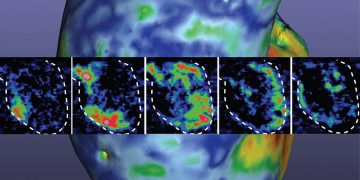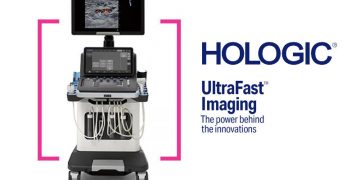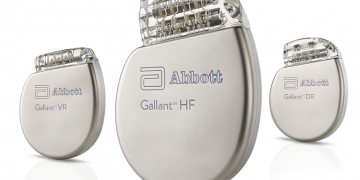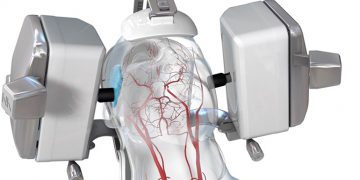Emerging evidence suggests that COVID-19 patients are at a higher risk of stroke and promptly diagnosing and treating such patients is a priority in hospitals across the world. Moreover, identifying which COVID-19 patients are at increased risk of developing a stroke is also important, and may help with preemptive treatment and monitoring.

The Lucid Robotic System, developed by LA-based Neural Analytics, is a transcranial doppler system that allows clinicians to identify clots and changes in blood flow in the brain in real time, without needing a specialized technician. The device is robotically assisted and automatically optimizes placement of the ultrasound probe, which can help to minimize clinician exposure when assessing COVID-19 patients.
Positioning the probe and patient takes less than five minutes, and the procedure can be performed at the bedside. Crucially, the device allows clinicians to rapidly identify blood clots in COVID-19 patients, and then implement timely treatment.
The system has already been used in COVID-19 patients, and may help clinicians to identify which patients are at higher risk of vascular complications. Neural Analytics has begun shipping units specifically to support the COVID-19 response. For instance, a unit sent to a hospital in New York was used to scan COVID-19 patients in the ICU the same day that it was delivered and installed.
Medgadget had the opportunity to talk to Diane Bryant, Chairman and CEO of Neural Analytics, about the technology.
Conn Hastings, Medgadget: Please give us an overview of the Lucid Robotic System.
Diane Bryant, Neural Analytics: Our founder, Dr. Robert Hamilton, developed the Lucid Robotic System as a means to monitor and assess the blood flow to the brain. It is the only fully automated, real-time method to non-invasively display the intensity and direction of intracranial blood flow. These data enable rapid identification of blood clots and other neurological abnormalities. Robert succeeded in his mission by combining long-established ultrasound technology with state-of-the art robotics and artificial intelligence. Brain illnesses, such as stroke, require immediate intervention to avoid life-long disability or death. The Lucid Robotics System uniquely provides precise insight into blood flow velocity, the existence of clots or other deposits, and the narrowing or widening of the blood vessels.
Brain derived illnesses have touched all our lives, whether personally or through someone close to us. Stroke, dementia, Alzheimer’s, traumatic brain injury, Parkinson’s disease – all manifest themselves in the brain. I personally find it distressing that in our annual physical check-ups our general practitioner informs us of the health of our heart and lungs but provides no insight into the health of our brain, an organ clearly as critical. At Neural Analytics, we strive to become the fifth vital sign.
Medgadget: How is the Lucid Robotic System being used in COVID-19 patients?
Diane Bryant: In mid-April we were contacted by three renowned medical institutions. Their message was consistent: emerging evidence showed COVID-19 patients are entering a hypercoagulable state leading to blood clotting in multiple organs including the lungs and brain. The medical community is faced with an alarming 700% increase in stroke for COVID patients under the age of 50 compared to historical norms. Patients of COVID-19 are emerging from ventilation with impaired speech, immobility, loss of memory and in some cases they do not survive.
The medical community requested the use of our Lucid Robotics System to continuously monitor the blood flow of COVID-19 patients. Once a patient is sedated and ventilated there is no other means to assess brain function. The clinical teams also face the issue of infection, necessitating limited exposure to the COVID-19 patient. The Lucid Robotics System allows them to maintain strict infectious disease protocols by robotically monitoring the patient from outside the room.
Medgadget: How long does it take to scan someone? How does the system avoid the need for specialized technicians?
Diane Bryant: The time to set up the robotic system and lock on the arteries in the brain is less than five minutes. The physician may view the blood flow for minutes in the identification of existing abnormalities, or may use the system for hours to continuously monitor the brain through surgeries or monitor in the neuro-intensive care unit to alert for possible strokes.
When the ultrasound-based transcranial doppler system was invented in 1982 it pledged to be the stethoscope of the brain. The technology failed to meet its vision due to the difficulty in locating the thinnest part of skull, providing the necessary window into the brain. We have solved that problem using robotics and artificial intelligence.
Medgadget: Please give us an overview of how data from the system may help to increase our understanding about which COVID-19 patients are at greater risk of stroke, and how this could influence pre-emptive treatment.
Diane Bryant: The medical community’s understanding of the COVID-19 virus continues to evolve. It affects different people in different ways. Infected people have had a wide range of symptoms and the death rate is alarming. Initially believed to be a typical acute respiratory distress syndrome like the flu, it increasingly appears this is not the case. The Lucid Robotics System provides a unique view into the disease. Just this past week our system was confirmed by the FDA to cover COVID-19 patients. Although our system was initially developed for illness of the brain, we have realized through our work with medical institutions that insights into pulmonary diseases like COVID-19 can be obtainable through analysis of cerebral blood flow. The body is clearly interconnected.
Our clinical training team has been working side by side with critical care physicians, scanning all COVID-19 patients. A paper was published on May 5th in the New England Journal of Medicine connecting COVID-19 and stroke. Scans of five patients under the age of 50 were completed and the results were staggering. All five showed physical signs of large-vessel stroke. We are working with Mount Sinai and other medical institutions to improve the outcome of COVID-19 patients through assessment and monitoring of blood flow through the brain. Our mission is to contribute to a better understanding of the virus, have a positive impact on COVID-19 patients, and reduce the impact of the disease nationwide.

Product page: Lucid Robotic System…
Link: Neural Analytics homepage…
Flashbacks: Now Available: Neural Analytics’ Lucid Robotic Ultrasound System for Brain Blood Flow Assessment; Lucid M1 Ultrasound Brain Damage Assessment System Cleared by FDA; Lucid M1 Brain Damage Assessment Transcranial Doppler Ultrasound System Now Available; Lucid M1 Transcranial Ultrasound Cleared in Europe to Help Assess Brain Damage














